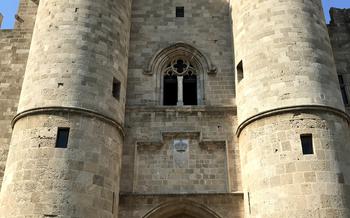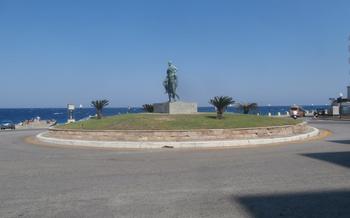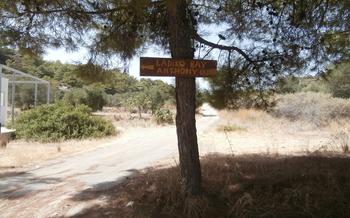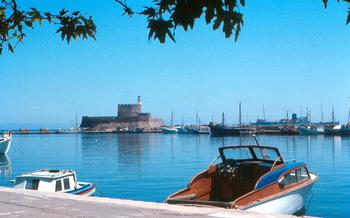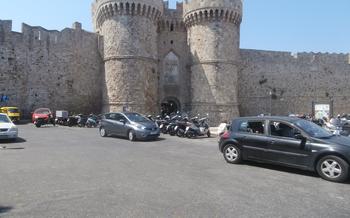
Italian Soldiers' Cemetery
- A War Cemetery with a Haunting History:
- Location and Accessibility
- Layout and Design of the Cemetery
- Sobering Memorials and Epitaphs
- Stories of Sacrifice and Bravery
- Historical Significance for Italy and Greece
- A Place for Reflection and Remembrance
- Exploring the Surroundings
- Respectful Etiquette and Behavior
- Tips for Planning Your Visit
- Photography and Documentation
- Local Insights and Personal Stories
- Preservation and Conservation Efforts
- Educational Programs and Commemorations
- Insider Tip: An Encounter with History
A War Cemetery with a Haunting History:
The Italian Soldiers' Cemetery in Rhodes stands as a solemn testament to the tragic consequences of war. Established in the aftermath of World War II, it serves as a final resting place for over 1,800 Italian soldiers who lost their lives during the Battle of Rhodes and the subsequent occupation of the Dodecanese Islands. The cemetery bears witness to the sacrifices made by these young men, far from their homeland, and the profound grief of their families and comrades.
As visitors walk through the meticulously maintained grounds, they are confronted with a poignant reminder of the human cost of war. The carefully tended rows of graves and the inscriptions on the headstones tell stories of bravery, loss, and the enduring legacy of conflict. The serene atmosphere of the cemetery invites contemplation and reflection on the futility of war and the importance of peace.
Location and Accessibility
Nestled amidst the tranquil hills of Rhodes, the Italian Soldiers' Cemetery is situated in the Kallithea area, just a short distance from Rhodes Town. Its serene setting provides a poignant backdrop to the stories of sacrifice and remembrance that dwell within its grounds.
To reach the cemetery, visitors can easily take public transportation from Rhodes Town or nearby areas. Regular buses depart from the city center and offer convenient access to the site. The journey takes approximately 15-20 minutes, allowing visitors to immerse themselves in the island's scenic landscapes as they approach their destination.
For those who prefer the flexibility of self-guided exploration, rental cars and taxis are readily available in Rhodes. With ample parking space near the cemetery, visitors can enjoy a leisurely drive and set their own pace for the visit.
Whether opting for public transportation or self-guided navigation, the Italian Soldiers' Cemetery is easily accessible and offers a serene haven for reflection and remembrance.
Layout and Design of the Cemetery
The Italian Soldiers' Cemetery in Rhodes stands as a testament to the sacrifices made by Italian soldiers during World War II. Its unique architectural features and overall design create a somber and respectful atmosphere that honors the fallen.
The cemetery is characterized by its symmetrical layout, with rows of white headstones arranged in neat formations. At the center of the cemetery lies a majestic monument dedicated to the fallen Italian soldiers, featuring intricate carvings and inscriptions that pay tribute to their bravery and sacrifice.
Each individual grave is marked with a headstone adorned with the soldier's name, rank, and unit, along with poignant epitaphs expressing grief and remembrance. The headstones are arranged in a way that allows visitors to easily read and reflect upon the lives of those buried here.
The cemetery is adorned with various symbols and inscriptions that hold deep meaning. The Italian flag, a symbol of national pride and unity, is prominently displayed throughout the cemetery. Visitors can also find inscriptions in Italian that express messages of hope, remembrance, and eternal rest.
The overall design of the Italian Soldiers' Cemetery in Rhodes is both aesthetically pleasing and deeply moving. It serves as a reminder of the tragic events of World War II and pays homage to the fallen soldiers who made the ultimate sacrifice for their country.
Sobering Memorials and Epitaphs
The Italian Soldiers' Cemetery in Rhodes is a place of profound sorrow and remembrance. The individual graves and headstones bear witness to the tragic loss of life during World War II. Each tombstone tells a unique story of sacrifice and grief, expressed through emotional messages and epitaphs.
Some epitaphs simply state the name, rank, and date of death of the fallen soldier, while others contain heartfelt messages from family members. There are expressions of love, sorrow, and longing, as well as tributes to the courage and bravery of the soldiers.
One particularly poignant epitaph reads: "Here lies our beloved son, who gave his life for his country. We will never forget his sacrifice." Another says: "To our dearest brother, who died a hero. Your memory will live forever in our hearts."
The personalized memorials create a deeply moving atmosphere in the cemetery. Visitors are often struck by the emotional weight of the epitaphs, which bring the human toll of war into sharp focus. It is a place where the past is made tangible, and the sacrifices made by these young men are remembered and honored.
When visiting the cemetery, it is important to be respectful and mindful of the emotions that surround these memorials. Visitors should maintain silence and refrain from any disruptive activities or disrespectful behavior. The Italian Soldiers' Cemetery is a place for reflection and remembrance, where the memory of the fallen is held sacred.
Stories of Sacrifice and Bravery
Beyond the poignant memorials and epitaphs, the Italian Soldiers' Cemetery in Rhodes holds within its grounds stories of extraordinary sacrifice and bravery. These were men who fought valiantly for their country, often in the face of overwhelming odds. Their selfless acts of courage and devotion to duty are a testament to the resilience of the human spirit.
One such story is that of Captain Luigi Randaccio, who led his company in a desperate defense against a superior force. Despite being outnumbered and outgunned, Randaccio and his men held their ground for hours, inflicting heavy casualties on the enemy. When his ammunition ran out, Randaccio refused to surrender and charged into the enemy ranks with his bayonet, sacrificing his own life to protect his comrades.
Another story is that of Private Antonio Rossi, a young soldier who volunteered to stay behind and cover the retreat of his unit. Armed with only a rifle and a handful of grenades, Rossi held off the enemy for over an hour, allowing his comrades to escape to safety. When he finally ran out of ammunition, Rossi detonated a grenade, taking several enemy soldiers with him.
These are just two examples of the countless acts of heroism that took place at the Battle of Rhodes. The Italian Soldiers' Cemetery is a living testament to the courage and sacrifice of these brave men, whose stories deserve to be remembered and honored.
Historical Significance for Italy and Greece
The Italian Soldiers' Cemetery in Rhodes holds profound historical significance for both Italy and Greece. It stands as a poignant symbol of reconciliation between the two nations, who fought on opposing sides during World War II. The cemetery serves as a reminder of the sacrifices made by young men from both countries, united in their shared fate and humanity.
Efforts to preserve and honor the memory of the fallen soldiers have been undertaken by both Italy and Greece. Joint commemorations and ceremonies are held annually at the cemetery, bringing together representatives from both countries to pay tribute to the fallen and promote peace and understanding. These events are a testament to the shared commitment to reconciliation and the recognition of the common tragedy experienced by both nations during the war.
The Italian Soldiers' Cemetery in Rhodes is not only a place of remembrance but also a symbol of hope for a future free from conflict and division. It stands as a reminder that even in the darkest of times, the human spirit can prevail, and that reconciliation and forgiveness are possible.
A Place for Reflection and Remembrance
The Italian Soldiers' Cemetery in Rhodes exudes an atmosphere of serenity and tranquility, inviting visitors to pause and reflect on the sacrifices made by the fallen soldiers. The meticulously maintained grounds, adorned with rows of white headstones, create a poignant and contemplative space.
- Visitors' Experiences:
Many visitors to the cemetery are struck by the profound emotions it evokes. The sight of the neatly arranged graves, each representing a life lost, serves as a powerful reminder of the human cost of war. Some visitors choose to pay their respects by placing flowers or lighting candles at the graves, while others simply stand in silence, lost in contemplation. The cemetery provides a space for visitors to remember and honor the fallen, regardless of their nationality or background.
- Importance of Remembrance:
The Italian Soldiers' Cemetery serves as a reminder of the importance of remembering historical events and the sacrifices made by those who fought for their country. It is a place where visitors can learn about the Battle of Rhodes and the broader context of World War II, and reflect on the futility of war and the devastating impact it has on individuals and families.
- Legacy of the Fallen:
The cemetery stands as a testament to the enduring legacy of the fallen Italian soldiers. Their sacrifice and bravery are forever etched in the history of Rhodes and continue to inspire and move visitors from around the world. The cemetery serves as a reminder that even in the darkest of times, acts of heroism and selflessness can shine through.
Exploring the Surroundings
Beyond the poignant history and somber atmosphere of the Italian Soldiers' Cemetery, visitors can delve deeper into the rich tapestry of Rhodes by exploring the surrounding area. A short walk from the cemetery leads to Monolithos Beach, a picturesque stretch of golden sand and turquoise waters, inviting visitors to bask in the Mediterranean sun and embrace the natural beauty of the island.
For those seeking further historical immersion, the village of Monolithos, perched atop a hill overlooking the sea, offers a glimpse into Rhodes' rich past. The imposing Monolithos Castle, a medieval fortress dating back to the 15th century, stands as a testament to the island's strategic significance throughout the ages. Visitors can wander through the castle's ruins, soak in the breathtaking panoramic views, and imagine the battles that unfolded within its walls.
Nature enthusiasts will find solace in the nearby Valley of the Butterflies, a verdant sanctuary teeming with thousands of brightly colored butterflies. Stroll along the serene paths, marvel at the kaleidoscope of colors fluttering around you, and immerse yourself in the tranquility of nature. The valley offers a serene contrast to the somberness of the cemetery, providing a reminder of the island's diverse natural wonders.
Rhodes Town, the island's capital, is a treasure trove of historical and cultural attractions, just a short drive from the Italian Soldiers' Cemetery. Explore the labyrinthine streets of the Old Town, a UNESCO World Heritage Site, and admire the architectural legacy left by different civilizations that have shaped Rhodes' history. Visit the Palace of the Grand Master, a magnificent fortress that once housed the Knights of St. John, and wander through the bustling markets, where you can find everything from traditional Greek handicrafts to culinary delights.
By venturing beyond the confines of the cemetery, visitors can gain a deeper understanding of Rhodes' multifaceted heritage, from its ancient roots to its modern-day vibrancy. The island offers a harmonious blend of history, nature, and culture, ensuring that every traveler finds something to cherish and remember.
Respectful Etiquette and Behavior
When visiting the Italian Soldiers' Cemetery, it is essential to maintain a respectful and solemn demeanor. The cemetery is a sacred place of remembrance for the fallen soldiers, and visitors should conduct themselves accordingly.
-
Silence and Reverence: Maintain silence and avoid loud conversations or disruptive noises. Show reverence for the fallen soldiers and their families by being mindful of your actions and words.
-
Appropriate Attire: Dress respectfully and modestly when visiting the cemetery. Avoid wearing revealing or casual clothing that may be deemed inappropriate in a place of remembrance.
-
Respectful Conduct: Refrain from running, playing, or engaging in any disrespectful activities within the cemetery grounds. Be considerate of other visitors who may be paying their respects or seeking a moment of contemplation.
-
Photography and Memorials: Be respectful when taking photographs. Avoid disturbing or posing near the graves or memorials. Always ask permission before photographing individuals or groups.
-
Leave No Trace: Ensure that you leave the cemetery as you found it. Avoid littering or leaving any personal belongings behind. Take all your trash with you and dispose of it properly.
By following these guidelines, visitors can demonstrate their respect for the fallen soldiers and contribute to the preservation of the cemetery's solemn atmosphere.
Tips for Planning Your Visit
To make the most of your visit to the Italian Soldiers' Cemetery, consider the following tips:
-
Timing: Visit during the early morning or late afternoon to avoid the midday heat and crowds. The cemetery is particularly atmospheric during sunset when the light casts a warm glow on the graves.
-
Duration: Plan to spend at least an hour exploring the cemetery. This will give you enough time to read the inscriptions, take photographs, and soak in the serene atmosphere.
-
Attire: Dress respectfully, as you would when visiting any other memorial site. Avoid wearing shorts, tank tops, or revealing clothing.
-
Respectful Behavior: Maintain silence and show reverence for the fallen soldiers. Avoid disruptive activities or loud conversations.
-
Photography: Photography is permitted at the cemetery, but be mindful of your surroundings and avoid disturbing other visitors.
-
Combining Visits: Combine your visit to the Italian Soldiers' Cemetery with other historical sites or activities in Rhodes. The nearby Acropolis of Lindos and the Old Town of Rhodes are both popular tourist destinations.
Photography and Documentation
When visiting the Italian Soldiers' Cemetery, it is important to be respectful and mindful in your photography. The cemetery is a place of remembrance and mourning, so it is essential to maintain a solemn and reverent atmosphere. Avoid taking intrusive or disrespectful photographs, and always ask permission before photographing any individuals or groups.
Focus on capturing the beauty and historical significance of the cemetery. Photograph the well-maintained grounds, the poignant memorials, and the serene atmosphere. Take close-up shots of the headstones to capture the inscriptions and personal messages. Consider using a wide-angle lens to capture the vastness of the cemetery and the rows of white crosses.
Document your personal experiences and reflections during your visit. Take photographs of yourself or your travel companions paying respects at the graves, or of any particularly moving or meaningful memorials you encounter. These photographs will help you remember your visit and the emotions you felt while there.
By capturing the essence of the Italian Soldiers' Cemetery through photography, you can raise awareness of this important historical site and educate others about its significance. Share your photographs online or in print, and accompany them with respectful captions that provide context and information.
Local Insights and Personal Stories
Engaging with the locals or experienced tour guides while visiting the Italian Soldiers' Cemetery can offer invaluable insights into their unique perspectives and personal stories related to the site. These individuals often possess a deep understanding of the cemetery's historical significance and its impact on the local community.
Through their narratives, visitors can gain a deeper appreciation for the sacrifices made by the fallen Italian soldiers and the enduring legacy of the cemetery. Personal anecdotes, family stories, and historical accounts shared by locals can bring the past to life and create a more profound connection to the site's somber history.
Listening to the local perspectives also helps visitors understand the significance of the cemetery beyond its historical context. The cemetery serves as a poignant reminder of the futility of war and the importance of peace and reconciliation. Locals may share their thoughts on the role of the cemetery in promoting understanding between Italy and Greece, as well as the efforts made to preserve and honor the memory of the fallen soldiers.
By engaging with the local community, visitors can gain a richer and more nuanced understanding of the Italian Soldiers' Cemetery, its historical significance, and its enduring impact on Rhodes.
Preservation and Conservation Efforts
The Italian Soldiers' Cemetery is a historical site of great importance, and significant efforts are made to preserve and conserve its integrity. Organizations such as the Italian Ministry of Defense and the Commonwealth War Graves Commission collaborate to maintain the cemetery's original design, restore damaged structures, and ensure the proper upkeep of the graves.
Visitors play a crucial role in preserving the cemetery by adhering to guidelines and showing respect for the site. Avoiding touching or leaning on the headstones, refraining from disturbing the surroundings, and adhering to designated pathways help maintain the cemetery's tranquility and historical authenticity.
Conservation efforts extend beyond physical preservation. Documenting and recording the stories and experiences of the fallen soldiers and their families helps preserve their legacy. Initiatives such as oral history projects, archival research, and digitalization of historical documents contribute to a deeper understanding of the cemetery's significance.
By supporting preservation efforts and being mindful of their actions, visitors contribute to the enduring legacy of the Italian Soldiers' Cemetery, ensuring that it remains a place of remembrance and historical reflection for generations to come.
Educational Programs and Commemorations
The Italian Soldiers' Cemetery in Rhodes serves as an educational platform to raise awareness about the history and significance of the site. Educational initiatives, such as guided tours, workshops, and seminars, are organized to provide visitors with a deeper understanding of the events that led to the establishment of the cemetery. These programs often include historical context, personal stories of the fallen soldiers, and discussions on the themes of war, sacrifice, and reconciliation.
Commemorative events and ceremonies are regularly held at the cemetery to honor the memory of the fallen soldiers and promote peace and understanding. These events may include wreath-laying ceremonies, memorial services, and exhibitions showcasing artifacts and documents related to the Battle of Rhodes and the Italian occupation of the Dodecanese Islands. Visitors are encouraged to participate in these commemorative activities to pay their respects and learn more about the historical significance of the site.
Educational programs and commemorations at the Italian Soldiers' Cemetery provide visitors with a unique opportunity to engage with history, remember the sacrifices made by the fallen soldiers, and promote peace and reconciliation. These initiatives contribute to a deeper understanding of the events that shaped the island of Rhodes during World War II and its aftermath.
Insider Tip: An Encounter with History
As you explore the Italian Soldiers' Cemetery, take a moment to engage with the local community. Strike up a conversation with a friendly resident or a knowledgeable tour guide. They may share fascinating stories, anecdotes, or personal connections to the cemetery that you would not find in guidebooks. Listen attentively to their perspectives, as they can provide a deeper understanding of the site's significance and its impact on the local people. By engaging with the community, you'll gain a richer and more meaningful experience, connecting you to the human stories behind the historical events.
